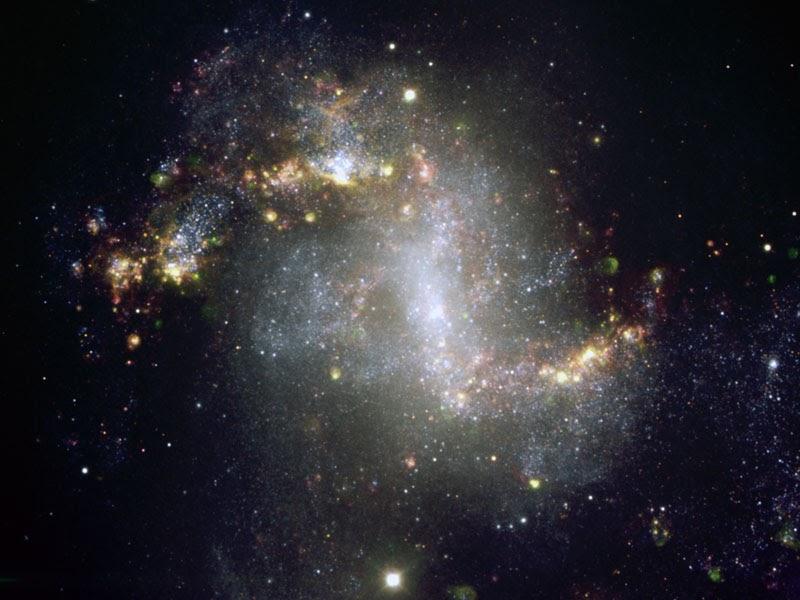in and beyond the Local Group
 Observations of resolved stellar populations with MOSAIC will enable us to trace and explore the star-formation and chemical-enrichment histories of large samples of galaxies. With current facilities, detailed spectroscopic observations of individual stars are limited to the Milky Way and its nearest neighbours, but reaching beyond the Local Group is essential in order to advance our understanding of how galaxies form and evolve under very different environmental conditions. MOSAIC will allow us, for the first time, to move to a broader range of galaxies in the Local Volume, from the edge of the Local Group out to Mpc distances, and to reach the faintest populations within the Milky Way. Observations of resolved stellar populations with MOSAIC will enable us to trace and explore the star-formation and chemical-enrichment histories of large samples of galaxies. With current facilities, detailed spectroscopic observations of individual stars are limited to the Milky Way and its nearest neighbours, but reaching beyond the Local Group is essential in order to advance our understanding of how galaxies form and evolve under very different environmental conditions. MOSAIC will allow us, for the first time, to move to a broader range of galaxies in the Local Volume, from the edge of the Local Group out to Mpc distances, and to reach the faintest populations within the Milky Way. | ||
The unique deep, high-density multi-fibre, and multi-IFU spectroscopic capabilities of MOSAIC will enable unprecedented statistical studies of resolved stellar populations in and beyond the Local Group. In order to provide meaningful constraints on theoretical models for galaxy formation and evolution, it is essential to push such studies beyond the Milky Way and its immediate neighbours to access larger, more diverse samples of galaxies. Within this general context, the questions that will be addressed by MOSAIC can be grouped into two broad overarching themes:
1) What are the star formation / chemical enrichment histories of a representative sample of galaxies in the Local Universe?
2) How does the physics of star formation and chemical enrichment differ between the early- and present-day Universe and in different environments?
Within the Local Group itself, MOSAIC will reach stars below the main sequence turn-off of the oldest stellar populations, which are far more numerous than the stars on the red giant branch that are accessible to current 8-10 m class telescopes. This will be crucial in order to measure the metallicity distributions in dwarf galaxies, in particular the metal-poor tails that constitute only a small fraction of the total numbers of stars but remain essential for understanding the earliest phases of galactic chemical enrichment. Furthermore, spectroscopy of stars down to the MSTO will provide a far clearer picture of the nucleosynthesis of chemical elements whose surface abundances in giants are affected by stellar evolutionary effects. Observations of Li in main sequence stars in dwarfs and turn-off stars in the Galactic bulge, halo, and Local Group galaxies will provide insight into the universality (or not) of the Spite plateau, and to lithium production and destruction in general.
Observations of red giant stars will be possible well beyond the Local Group, including galaxies in the Sculptor group (NGC 55, NGC 300), and will provide insight into the spectroscopic metallicity distributions (e.g. via observations of the Ca II IR triplet) and kinematics of stellar halos, outer regions of galactic discs, and other components of galaxies. MOSAIC will also be able to measure detailed chemical abundances for more than a thousand globular clusters in the nearest giant elliptical galaxy, Centaurus A, allowing a direct comparison with existing data for GCs in the Local Group, and potentially applying chemical tagging to identify past accretion events. The brighter GCs will be observable out to the Fornax galaxy cluster and beyond.
Tracers of young stellar populations, such as red and blue supergiants and super star clusters (SSCs) will be observable at far greater distances, potentially out to 100 Mpc and beyond. Observations in the infrared spectral range are well suited for red supergiants and SSCs with ages in the range 10–100 Myr, which are extremely bright in the IR. Such studies will benefit not only from the tremendous light gathering power of the ELT, but also from the adaptive optics correction to overcome crowding and blending of individual sources. Such observations will allow detailed studies of the chemical composition of young stellar populations in a wide range of galaxy types not represented in the Local Group, such as spiral galaxies with very low or very high star formation intensities (e.g. NGC 45, M83, NGC 1313), and more extreme starburst environments such as those associated with major mergers.
